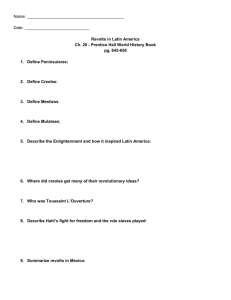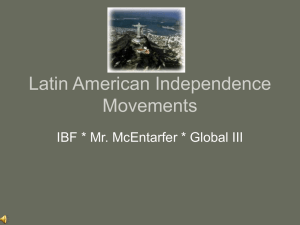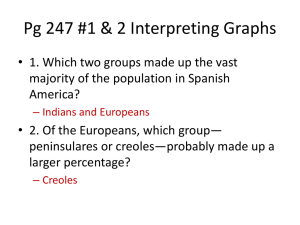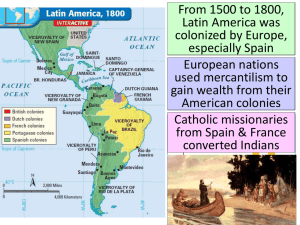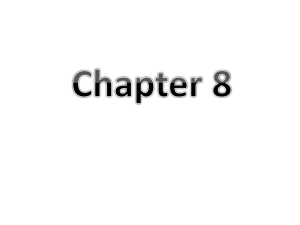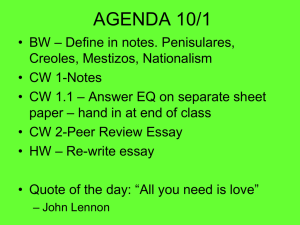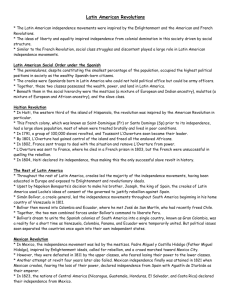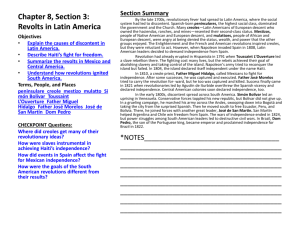Latin American nations
advertisement
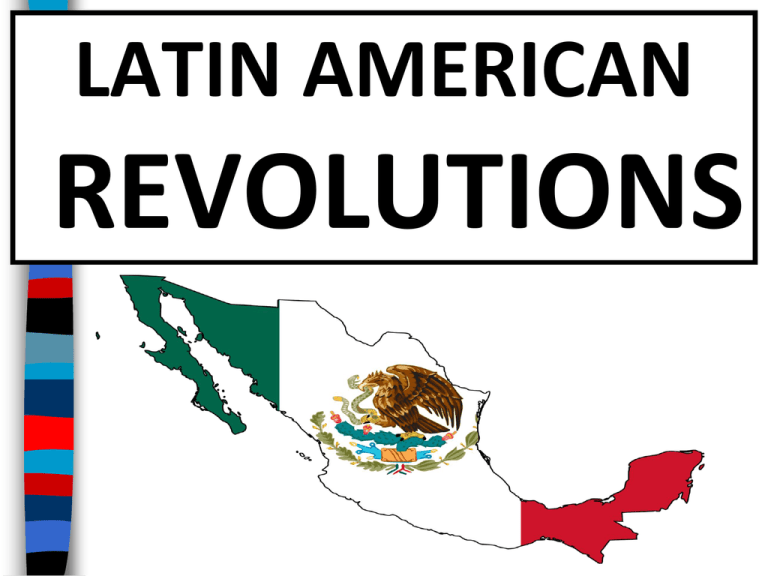
LATIN AMERICAN REVOLUTIONS Essential Question: What were the main causes and effects of Latin American revolutions? Which group made up the Second Estate in French society? A. B. C. D. The Roman Catholic clergy The bourgeoisie The peasants The nobles #1 Why did King Louis XVI call a meeting of the Estates-General in 1789? A. He feared the spread of Enlightenment ideas in France B. He hoped to find solutions to France’s severe economic crisis C. He wanted to bring an end to the Reign of Terror D. He wanted to suggest a government based on limited monarchy #2 How did the Third Estate respond to the king’s proposal during the Estates-General? A. Immediately executed Louis XVI B. Changed laws so that all decisions would be by “order” not by “head” C. Formed the National Assembly D. Destroyed copies of Declaration of the Rights of Man and of the Citizen #3 Which event is considered to be the symbolic beginning of the French Revolution? A. The execution of Louis XVI B. Women’s demand for bread at the Versailles Palace C. The formation of the National Convention D. Mobs of people storming the prison at Bastille #4 Which of the following French governments has the WRONG description? A. Government before the French Revolution = Absolute Monarchy B. National Assembly = Limited Monarchy C. National Convention = Democratic Republic D. Government after the Reign of Terror = Absolute Monarchy #5 Which group made up the Second Estate in French society? A. B. C. D. The Roman Catholic clergy The bourgeoisie The peasants The nobles #1 ANSWER: D Why did King Louis XVI call a meeting of the Estates-General in 1789? A. He feared the spread of Enlightenment ideas in France B. He hoped to find solutions to France’s severe economic crisis C. He wanted to bring an end to the Reign of Terror D. He wanted to suggest a government based on limited monarchy #2 ANSWER: B How did the Third Estate respond to the king’s proposal during the Estates-General? A. Immediately executed Louis XVI B. Changed laws so that all decisions would be by “order” not by “head” C. Formed the National Assembly D. Destroyed copies of Declaration of the Rights of Man and of the Citizen #3 ANSWER: C Which event is considered to be the symbolic beginning of the French Revolution? A. The execution of Louis XVI B. Women’s demand for bread at the Versailles Palace C. The formation of the National Convention D. Mobs of people storming the prison at Bastille #4 ANSWER: D Which of the following French governments has the WRONG description? A. Government before the French Revolution = Absolute Monarchy B. National Assembly = Limited Monarchy C. National Convention = Democratic Republic D. Government after the Reign of Terror = Absolute Monarchy #5 ANSWER: D From 1500 to 1800, Latin America was colonized by Europe, especially Spain European nations used mercantilism to gain wealth from their American colonies Catholic missionaries from Spain and France converted Indians One major impact of European colonization was the unequal ■ Text social hierarchy in Latin America White Europeans were at the top of society Peninsulares were royal governors who were born in Spain; they were sent by the king to enforce mercantilism and maintain order in the colony White Europeans were at the top of society Spanish colonists who were NOT born in Spain and were living in America were called creoles; they had land and wealth, but had no political power The lack of European women in America led to intermarriage with Indians and Africans; from this, there came a large mixed-race population that made up the next level of the social hierarchy Mestizos were the offspring of Europeans and Indians Mulattos were the offspring of Europeans and Africans Indians and Africans made up the bottom of the social hierarchy Indians and Africans were used as slave workers for creoles plantations From 1800 to 1830, Latin American colonies began declaring independence from European nations and establishing democracies throughout the Americas Quick Class Discussion: (1) Which social groups will lead these Latin American Revolutions? Why? (2) Where did they get the idea to revolt and create democracies? African slaves in Haiti Creoles in South America Indians in Mexico By the late 1700s, Latin Americans were inspired to gain independence because of the success of the American and French Revolutions The ideas of the Enlightenment inspired independence especially among the well-educated creole class Haiti was the first Latin American colony to free itself from European rule Haiti was a French colony with 500,000 African slaves working on sugar and coffee plantations Plantation owners used brutal methods to control slaves In 1791, Haitian slaves rose in revolt; Toussaint L’Ouverture became the leader of the slave uprising and helped free all the slaves by 1801 From 1802 to 1804, Haitians fought for their independence against Napoleon’s French army In 1804, France granted Haiti its independence and created a republic Throughout the Spanish colonies in South America, the creoles had wealth and education but could not participate in government Creoles embraced Enlightenment ideas like natural rights and consent of the governed In 1810, the demand by creoles for political rights led to revolutions throughout South America South American nations gained their independence because of the leadership of two creole generals From 1811 to 1824, Venezuelan creole Simon Bolivar led an army of revolutionaries against Spain Bolivar helped create new nations of Gran Colombia, Peru, and Bolivia Argentinean creole San Martín led the independence movement in southern South America San Martín helped create new nations of Argentina, Chile and Peru Unlike the South America creoles, in Mexico the Indians and mestizos played the leading role In 1810, a poor but well educated Catholic priest named Miguel Hidalgo used Enlightenment ideals to call for a revolution against Spain Hidalgo led an army of 80,000 Indian and mestizo revolutionaries against the Spanish military and creoles who feared losing their wealth During the rebellion, Hidalgo was killed but Mexicans found new leaders to continue the fight another 10 years The turning point in the war came in 1820 when the creoles switched sides and joined the revolt against Spain In 1821, Spain granted Mexico its independence and a republic was formed Throughout Latin America, new democratic republics were created However, Latin Americans did not have a history of selfgovernment and many of the new governments were unstable In many nations, military dictators called caudillos seized power and made few reforms for citizens Latin American nations (like Mexico) became dependent on the United States of America for protection from European nations Closure Activity ■ Creating an Enlightenment Encyclopedia: –Working with a partner, create an entry into Diderot’s Encyclopedia about one key idea or person of the Enlightenment –Use the template provided to provide a brief summary of the person/idea & create a brief sketch –When finished, hang it up in the room to create a classroom encyclopedia –Be prepared to present on your topic title summary sketch your names Encyclopedia Entries 1. Colonial assemblies 2. Reasons for the American Revolution 3. “No Taxation without Representation” 4. Declaration of Independence 5. American Revolution 6. Constitution 7. Thomas Jefferson 8. Reasons for the French Revolution 11. Declaration of the Rights of Man and of the Citizen 12. National Convention 13. Louis XVI 14. Maximilien Robespierre 15. Reign of Terror 16. Napoleon Bonaparte 17. Latin American social classes 18. Toussaint L'Ouverture 19. Simon Bolivar 9. Estates-General 20. San Martín 10. National Assembly 21. Miguel Hidalgo
